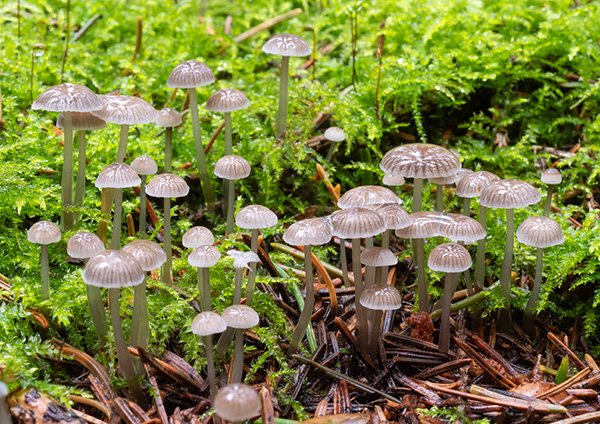Gregarious on fallen coniferous needles. Autumn. Widespread in the area covered and mostly common but less frequent in lowlands of western parts. Widely distributed and very common in southern parts of Norway. Often occuring in great numbers. Recorded north to Nordland County.
Pileus 5-20 mm across, conical to parabolical
or convex, occasionally with a pointed umbo or somewhat
depressed in the centre, flattening with age, sulcate, translucent-striate,
lubricous to viscid, glabrous, covered with a separable,
gelatinous pellicle, dark brown at the centre, paler brown
to greyish brown towards the margin. Lamellae 14-25 reaching
the stipe, arcuate, broadly adnate to decurrent, veined
and dorsally intervenose with age, pale grey to pale grey-brown;
the edge separable as an elastic-tough thread, paler or
concolorous. Stipe 20-60 x 1-1.5 mm, hollow, equal or somewhat
wider at the apex, straight to flexuous, pruinose above,
glabrous for the greater part, glutinous to viscid, covered
with a separable, gelatinous pellicle, whitish at the apex,
grey-brown to fairly dark brown farther below, the base
covered with long, coarse, whitish fibrils. Odour none or
somewhat fruity farinaceous. Taste reported as raphanoid.
Basidia 22-33 x 6-9.5 µm, clavate, 4-spored, with sterigmata 4.5-5.5 µm long. Spores
7-9(-11) x 3.5-4.5(-5) µm, Q 1.8-2.2, Qav ≈ 2, pip-shaped, smooth, amyloid.
Cheilocystidia 18-35 x 2-4.5 µm, forming
a sterile band, cylindrical, embedded in gelatinous matter,
terminated by much branched, gelatinizing excrescences2-13 x 1-2.5 µm. Pleurocystidia absent. Lamellar trama dextrinoid. Hyphae
of the pileipellis 2.5-3.5 µm wide, smooth or somewhat diverticulate
with cystidia-like terminal cells with much branched excrescences,
embedded in gelatinous matter. Hyphae of the cortical layer
of the stipe 1.5-3.5 µm wide, smooth, tortuous, embedded in gelatinous matter,
terminal cells densely diverticulate. Clamp connections present in all tissues.
Mycena vulgaris is a species of section
Fuliginellae, of which only seven species
are known, four in North America and three in Europe. Four
species have, like M. vulgaris, arcuate lamellae.
M. austinii (Peck) Kühner can be distinguished
on account of of its white pileus, presence of a basal disc, clavate
cheilocystidia and presence of pleurocystidia. M. mackinawensis
A. H. Sm. is different because of clavate cheilocystidia,
presence of pleurocystidia, differently shaped terminal
cells of the hyphae of the pileipellis, and occurrence on
coniferous branches. M. agrestis
differs in having somewhat larger
spores, differently shaped cheilocystidia, and no association
with conifers. M. geesterani Heykoop, Esteve-Rav.
& G. Moreno, recently described from Spain, is supposed
to have smaller spores (4-5 x 2-2.5 µm) that are more
strongly amyloid. It was also described with white lamellae
with ochre-yellowish to reddish shades.
A quite aberrant collection
of Mycena vulgaris was found by this author in
2003. It deviated from normal M. vulgaris by a
black apex of the stipe and blackish to dark grey pileus.
The microscopic details, however, did not differ from typical
M. vulgaris.
Because of the viscid appearance of the pileus
and stipe M. vulgaris could be taken for a member
of sect. Hygrocyboideae. M. vulgaris, however, never shows any yellow colours
which are so conspicuous in most varieties of Mycena
epipterygia, and in the latter the lamellae are
ascending and adnate (although decurrent with a tooth),
never arcuate. The two varieties of M. epipterygia
lacking yellow shades, var. fuscopurpurea and var.
pelliculosa do not
grow on coniferous needles. The spores of M. epipterygia are larger, and the hyphae of the pileipellis are branched,
anastomosing, often forming dense masses.
Another species with a lubricous pileus (at
least in moist conditions) and a glutinous stipe together
with somewhat decurrent lamellae is Mycena
clavicularis. It has, however, not
a separable pellicle nor a separable lamellar edge, and
the microscopy is completely different.

|